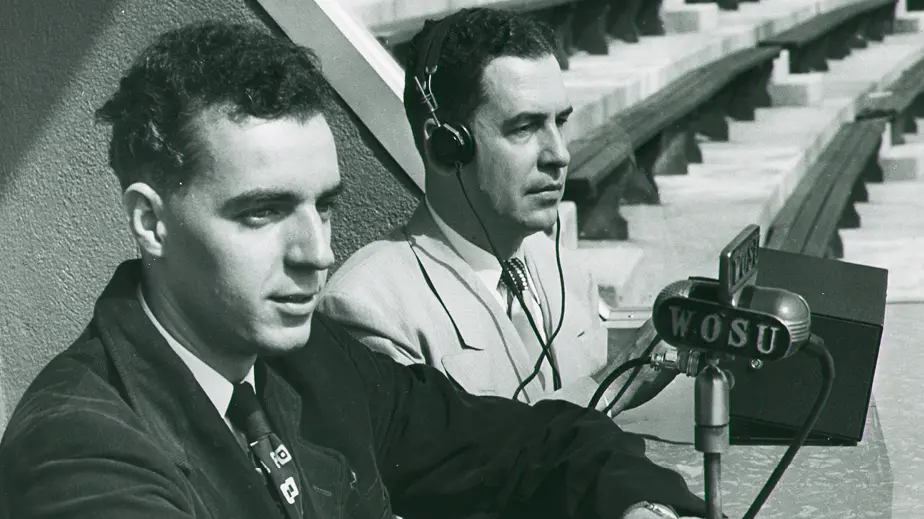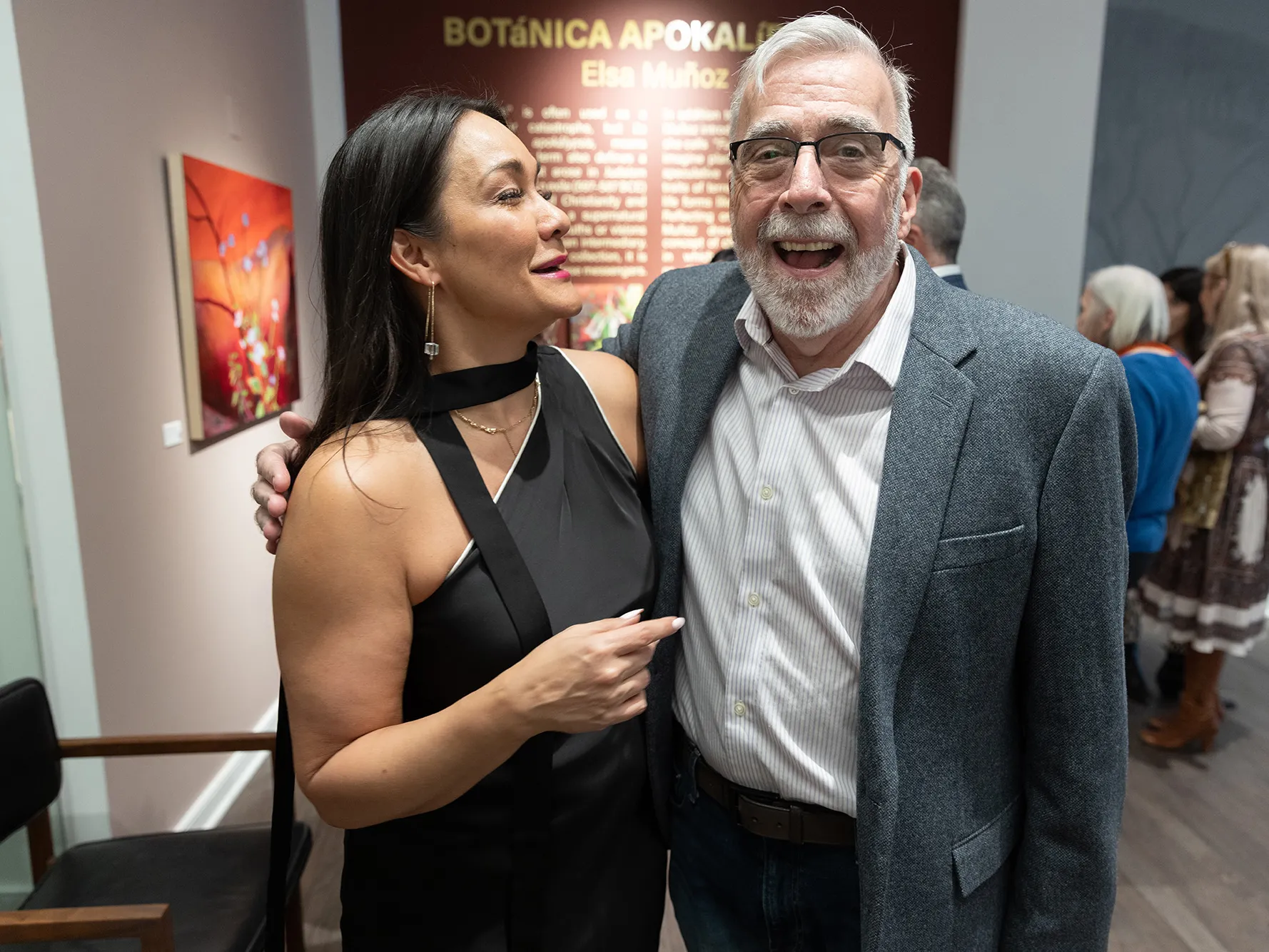Marv Homan: A man as kind as he was important
Join us in remembering the Ohio State athletics stalwart and longtime broadcasting voice of the Buckeyes, who died this year.

Through four decades of service, Marv Homan (left) was a fixture in the Ohio State athletics department.
A voice from his childhood greeted small-town sports editor Rusty Miller inside the Ohio Stadium press box in the autumn of 1977. There stood Marv Homan, a fixture in the Buckeyes’ athletics department since 1949, welcoming Miller to Columbus and accommodating all of his pre-game needs.
Growing up in rural north-central Ohio, Miller and his four brothers spent Saturday afternoons in the fall listening to Homan broadcast Ohio State football games throughout the 1960s. This was decades before the emergence of high-definition television and sports bars. Across the state, Buckeyes fans gathered around radios to hear Homan call games.
The bespectacled announcer was an extension of the Ohio State teams he covered. Homan met almost daily with legendary coaches such as Woody Hayes and Fred Taylor during their respective tenures and described to his listeners the glories of three Heisman Trophy winners and two future NBA stars.
But what resonates to this day among those who worked in his orbit was Homan’s humility and kindness. He was an omnipresent figure for nearly 40 years around the university’s sports programs, yet he never carried himself like a man of importance.
Homan, who helped transform the university’s sports information department, died June 2, 2021, at the age of 94.
“He was a wonderful person,” says Miller, who rose from sports editor of the Bucyrus Telegraph Forum to cover Ohio State athletics for 30 years with the Associated Press. “You can spend two hours with some people and they will never talk about you or your family. They will only talk about themselves and what they have done and where they have been. Marv lived that life, but he would never make the conversation about him.”
Homan served as the eyes for his listeners as Jerry Lucas and John Havlicek led the Buckeyes to a 1960 NCAA basketball title. He was at the Rose Bowl eight years later describing the action as the football team — the one with 11 All-Americans and six future NFL first-round draft picks — put an exclamation point on a perfect season and national championship with a win over the University of Southern California.
His radio calls were distinct and clear, free of jargon, rarely a word out of place. That’s fitting, as Homan had graduated from Ohio State in 1948 with a degree in English, and his college roommate was Jack Buck, the iconic sportscaster best known as the voice of the St. Louis Cardinals.
“There would be no greater joy than to listen to Marv and Jack tell stories somewhere about their careers over a couple of bourbons,” says former sports information intern Rick Van Brimmer ’81 ’83 MA, now the university’s assistant vice president for trademark and licensing services.
Homan broadcast Ohio State football games for 30 years and called men’s basketball games for 20 seasons. He assisted in the university’s sports information department from the time he graduated until he became its director in 1973. He continued in that lead role for 14 years.
There was no such thing as digital media, Twitter or even the internet during this era. Homan’s staff of four full-timers and interns, operating out of a cramped first-floor office in St. John Arena, gathered on Sundays in the fall to write press releases recapping the latest football game and previewing the next one. Interns hand-delivered mimeographed releases to Columbus-area media outlets, while the rest were dispatched through the mail.
“I can’t remember if we had a folding machine or not, but we would stuff over 1,000 envelopes,” says former sports information intern and staffer Bob Goldring ’81, ’82 MA, an executive with the Ohio High School Athletic Association. “We would take most of them to the main post office that night.”
“He was polite. He was humble. He was quiet. You would never know the kind of role he played at Ohio State for all those years.”
Few college athletic departments in the nation had a sports information office that plied media members with more information during that era. But even as the advent of word processors made work easier for the department, Homan delivered his copy on a manual typewriter until his 1987 retirement.
Over 39 years of service, he missed only one of 403 football games, according to his bio for a book he co-wrote with former Columbus Dispatch sports editor Paul Hornung. Homan’s career spanned Hayes’ entire 28-year run as the Buckeyes’ coach and included coverage of three Heisman winners: Archie Griffin ’76, Vic Janowicz ’52 and Howard “Hopalong” Cassady ’57.
Reporters and former interns marveled at Homan’s encyclopedic recall of athletics events. The books he authored, chronicling Ohio State sports, became invaluable resource material for writers covering the Buckeyes.
Longtime Ohio State football reporter Tim May says Homan’s experience as a broadcaster helped in his relationship with reporters. He appreciated the value of a statistical nugget and well-told anecdote.
For example, it wasn’t enough for a reporter to write that Lucas had a photographic memory. Homan supplied Miller with a remarkable story to illustrate it: In the early 1960s, Homan and the basketball star sat at a table over breakfast for about 10 minutes in West Lafayette, Indiana, the morning of a game. They had been discussing ancient Rome, with Lucas occasionally glancing up at the hotel restaurant’s wallpaper.
As Lucas excused himself, he muttered “1,529” under his breath. The endlessly curious Homan inquired about the random comment. “Jerry tells Marv, ‘Oh, there’s a pattern in the wallpaper back there and it appears 1,529 times,’” Miller says, recalling the tale years later.
Homan was presented the Arch Ward Meritorious Service Award by the College Sports Information Directors of America in 1988, and he became just the fourth administrator to be inducted into the Ohio State Athletics Hall of Fame in 2007.
In the high-pressure world of sports information, Homan was not one to lose his temper or chide reporters for silly questions and uninformed remarks. On March 12, 1987, Homan appeared as a guest for a Lexington, Kentucky, television station to help preview the Ohio State-Kentucky tournament basketball game. The reporter closed the segment by asking, “How’s our old buddy Woody Hayes doing?”
“Marv was startled,” Goldring recalls. “But he composed himself and said, ‘Oh, I guess you didn’t hear. Woody had a little bit of bad news today. He died.’”
For all his achievements, Homan might be best remembered for his patience, professionalism and willingness to help others, whether they wrote for Sports Illustrated or a small-town newspaper.
“The very first thing you think of when you think of Marv Homan is what a nice man he was, and you underline the word ‘nice,’” May says.



